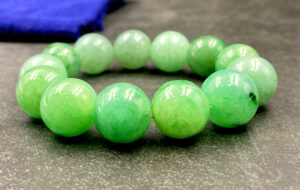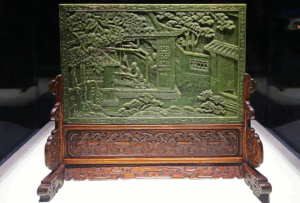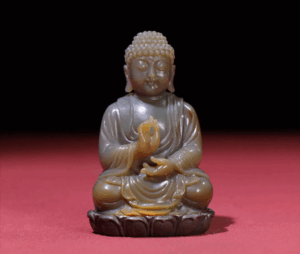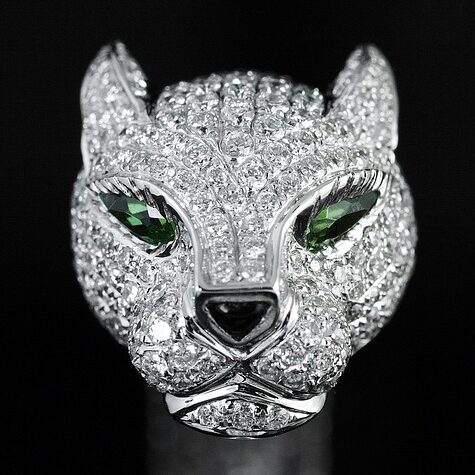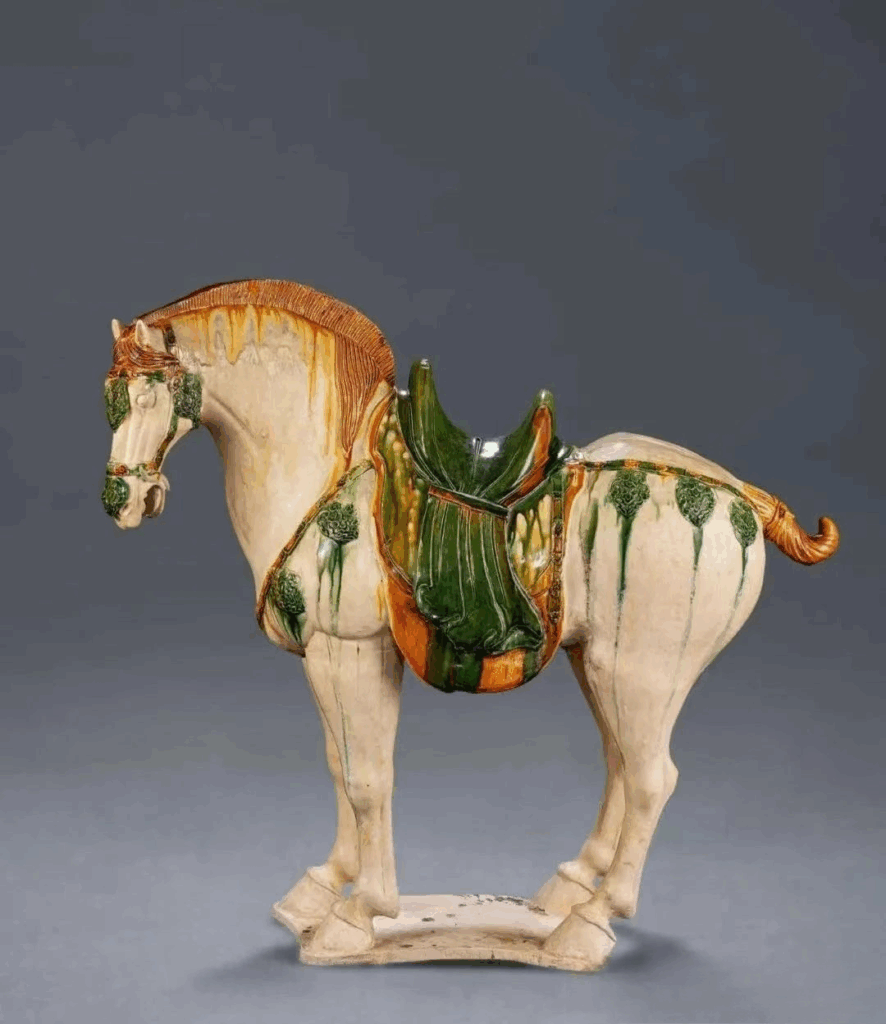
Tang Sancai: The Radiance of a Golden Age Captured in Glaze
When Clay Became Poetry: The Alchemy of Tang Sancai
Tang Sancai (唐三彩) isn’t merely pottery—it’s frozen sunlight from China’s cosmopolitan zenith. These low-fired lead-glazed wares embody the Tang dynasty’s technicolor soul, where Persian cobalt met Chinese clay and Buddhist symbols danced with Central Asian camels. At VirtuCasa, we decode their secrets through XRF glaze analysis and 3D tomb context recreation, preserving their legacy for the digital age.
當泥土成為詩篇:唐三彩的煉金術
唐三彩不僅是陶器——它是中國盛世凝結的日光。這些低溫鉛釉器承載著大唐的絢爛靈魂:波斯鈷料遇見中國陶土,佛教符號與中亞駱駝共舞。VirtuCasa透過XRF釉料分析與3D墓葬情境重建解讀其奧秘,為數字時代保存這份遺產。
Chapter 1: The Technical Marvel – How Sancai Defied Physics
1.1 The Double-Firing Revolution
- Process:
- Body firing: 1000°C for white kaolin clay
- Glaze firing: 800°C with lead-silicate base + metal oxides
- Color Chemistry:
- Cobalt → Blue (imported from Persia)
- Copper → Green (Chinese malachite)
- Iron → Amber (local limonite)
第一章:技術奇蹟——唐三彩如何突破物理限制
1.1 二次燒造革命
- 工序:
- 素燒:1000°C高嶺土定型
- 釉燒:800°C鉛硅酸鹽基底+金屬氧化物
- 呈色化學:
- 鈷 → 藍(波斯進口)
- 銅 → 綠(中國孔雀石)
- 鐵 → 褐(本地褐鐵礦)
(Image: Diagram of glaze flow patterns showing lead-silicate movement during cooling)
1.2 The “Wax-Resist” Secret
Tang artisans adapted batik textile techniques to ceramics:
- Beeswax barriers: Created precise patterns like lotus petals
- Layered glazing: Up to 5 separate glaze applications
- Intentive runs: Controlled drips simulated mountain landscapes
1.2 「蠟防」秘技
唐代匠人將蠟染技術運用於陶瓷:
- 蜂蠟隔斷:形成精確紋樣(如蓮瓣)
- 多層施釉:最多5層獨立釉層
- 可控流釉:模擬山水景致的故意流動
Chapter 2: The Cultural Code – More Than Tomb Goods
2.1 Global Signifiers
- Camels: Silk Road trade (often carrying Central Asian musicians)
- Court ladies: Plumpness = wealth (contrasted with Han dynasty slimness)
- Demonic figures: Guardian zhenmushou (鎮墓獸) with Persian influences
2.2 Daily Use Evidence
2015 Xi’an excavations revealed:
- Sancai tableware in residential districts
- Glazed architectural tiles for temples
- Miniature sets for children’s tombs (indicating cherished status)
第二章:文化密碼——不僅是明器
2.1 全球符號
- 駱駝:絲綢之路貿易(常駝中亞樂手)
- 仕女:豐腴=財富(與漢代纖瘦對比)
- 鎮墓獸:受波斯影響的守護神
2.2 日用證據
2015年西安發掘顯示:
- 居民區出現三彩餐具
- 寺廟使用釉面建築磚
- 兒童墓中縮小套組(表明珍愛地位)
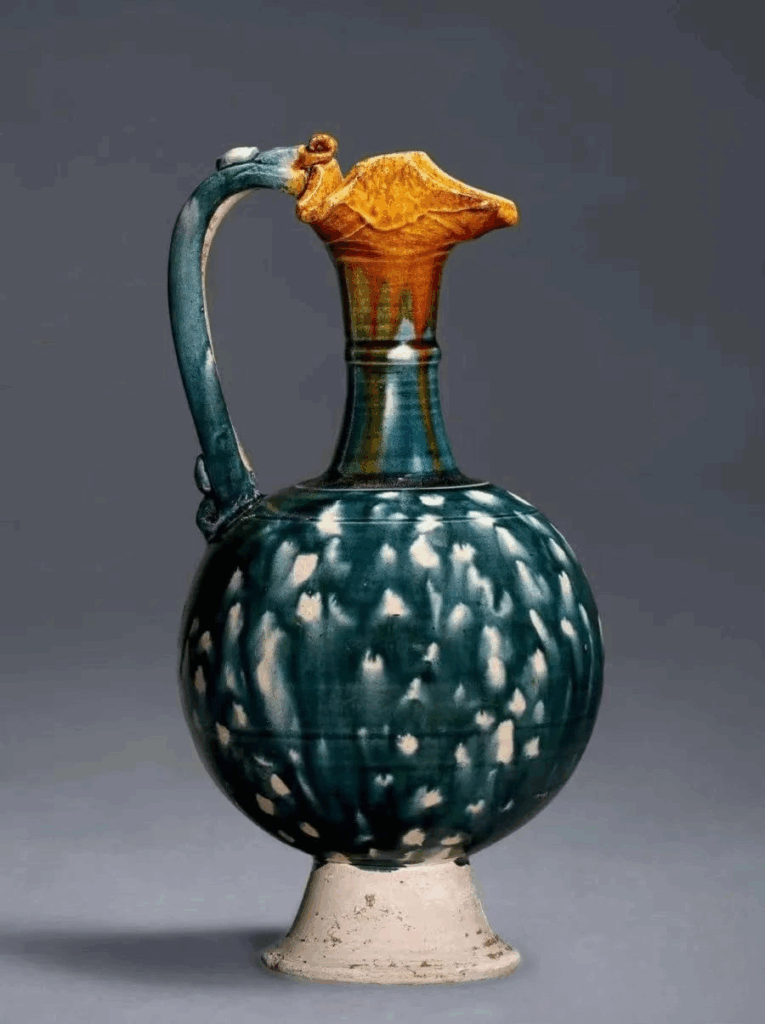
Chapter 3: The Authentication Guide – 7 Tests Time Can’t Fake
3.1 Iridescence (蛤蜊光)
- Formation: 1000+ years of lead glaze devitrification
- Test: Tilt under natural light—rainbow hues should float above surface
- Fake alert: Modern chemical iridescence sits within glaze layer
3.2 Earth Corrosion (土蝕)
- Authentic: Random micro-pits with depth variation (0.1-2mm)
- Forgery: Uniform acid etching (all pits same depth)
第三章:鑑真指南——時間無法偽造的7大特徵
3.1 蛤蜊光
- 成因:千年鉛釉析晶
- 檢測:自然光下傾斜——彩虹光應浮於釉表
- 偽警:現代化學虹光沉於釉層內
3.2 土蝕痕
- 真品:隨機微孔且深度不一(0.1-2毫米)
- 仿品:均勻酸蝕(所有孔洞深度一致)
Chapter 4: The Modern Market – From Tomb to Auction House
4.1 Price Benchmark (2024)
| Object | Price Range (HKD) |
|---|---|
| Blue-glazed figure | 1.5-2M |
| Camel with musician | 2.6-3.5M |
| Architectural tile | 0.8-1.2M |
| Complete tomb set | 10M+ |
4.2 Collection Strategy
- Focus: Items with export evidence (Silk Road provenance)
- Avoid: Over-restored pieces (>30% reconstruction)
- Verify: Use UV flashlight to detect modern fillers (epoxy fluoresces blue)
第四章:現代市場——從墓葬到拍賣行
4.1 價格基準(2024年)
| 器物類型 | 價格區間(港幣) |
|---|---|
| 藍釉俑 | 150-200萬 |
| 駝載樂伎駱駝 | 260-350萬 |
| 建築構件 | 80-120萬 |
| 完整墓室套組 | 1000萬以上 |
4.2 收藏策略
- 重點:具出口痕跡作品(絲綢之路來源)
- 避開:過度修復(>30%重建)
- 驗證:紫外手電檢測現代填充物(環氧樹脂發藍光)
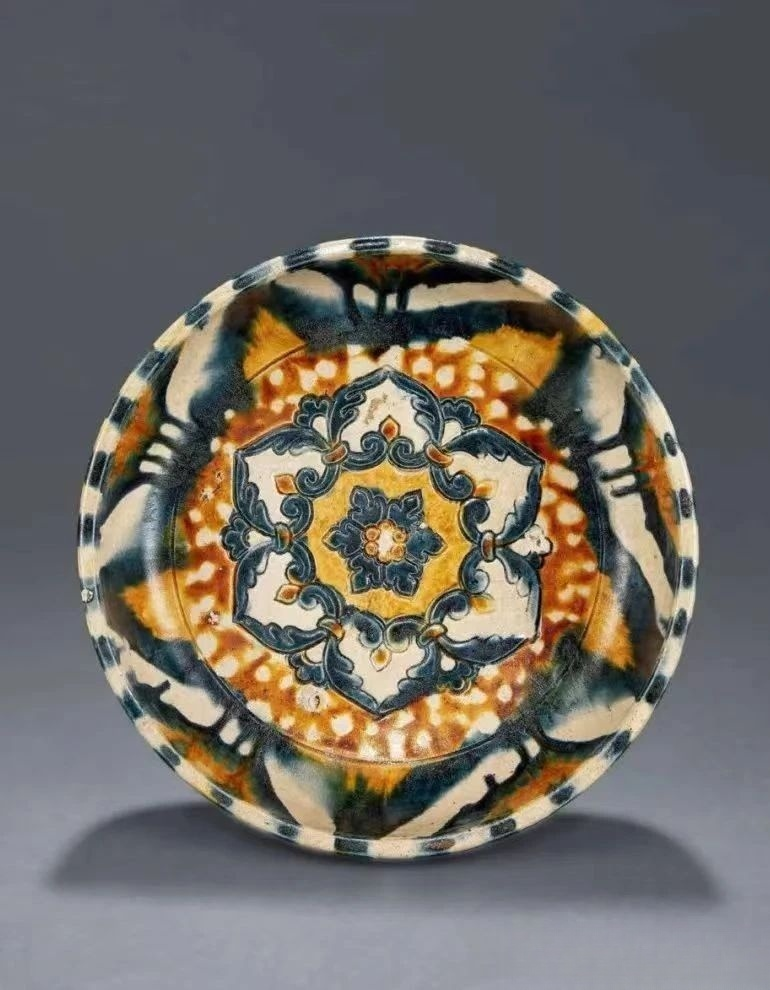
VirtuCasa’s Sancai Protocol
We ensure authenticity through:
- TL Dating: Thermoluminescence tests firing date ±50 years
- Glaze Mapping: AI compares bubble patterns to dated museum pieces
- NFT Tomb Cards: Digital recreation of archaeological context
VirtuCasa的三彩鑑證協議
我們透過以下方式確保真實性:
- 熱釋光測年:測定燒造年代±50年
- 釉層繪圖:AI比對氣泡模式與博物館紀年藏品
- NFT墓卡:考古情境數字化重建
Why Sancai Outshines Other Ceramics
As Tang poet Li Bai wrote: “Color drunk, glaze dream—this clay holds forever spring.” These objects capture the Tang’s radical openness—where foreign pigments merged with Chinese forms to create something never seen before or since.
為何三彩超越其他陶瓷
正如李白詩云:「色醉釉夢——此土永駐春。」這些器物體現了大唐的極度開放——異國顏料與中國形制融合,創造出前無古人後無來者的奇蹟。
Read More
- Jadeite Through the Seasons: A Guide to Year-Round Wear and Care
- Understanding Bronze Vessels: Types and Terminology
- Qing Dynasty Porcelain Techniques: Blue-and-White and Underglaze Red
- Metamorphosis: Chinese Sculpture Through the Dynasties
- Exploring Ding Kiln’s Diverse Charms: A Complete Guide to Appreciation

